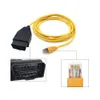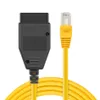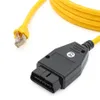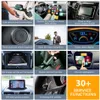If you’re a BMW owner, investing in an ENET cable for diagnostics is definitely worth considering. The advantages of using an ENET cable are numerous – from faster and more accurate communication between the car and diagnostic tools, to more precise readings and better diagnosis of issues. In this article, we’ll provide step-by-step instructions on how to use the ENET cable with BMW cars. We’ll also discuss the cable’s durability, highlighting the quality materials used in its construction that allow it to last longer than other cables on the market. With an ENET cable, not only will you be able to save time and money on diagnostics, but you can ensure your BMW is running smoothly for years to come.








ENET Cable Benefits
When it comes to diagnosing issues with your BMW, using the right tools is crucial. One such tool that has been gaining popularity among BMW owners and mechanics is the ENET cable. This innovative cable provides a range of benefits for BMW diagnostics, offering faster and more accurate communication between the car and diagnostic tools.
One of the key benefits of using an ENET cable for BMW diagnostics is the speed at which it enables communication between the car and the diagnostic tools. Unlike traditional OBD-II cables, the ENET cable uses Ethernet protocol, allowing for much faster data transfer. This means that diagnostic tools can receive information from the car more quickly, leading to more efficient and timely diagnosis of issues.
In addition to speed, the ENET cable also provides more accurate communication between the car and diagnostic tools. This accuracy is crucial for obtaining precise readings and ensuring that issues are diagnosed correctly. Traditional OBD-II cables may not always provide the level of accuracy needed for complex BMW diagnostics, but the ENET cable fills this gap by delivering reliable and exact communication.
The combination of faster and more accurate communication offered by the ENET cable leads to better diagnosis of issues with BMW vehicles. Mechanics and car enthusiasts who use this cable can have greater confidence in the readings and results they obtain, ultimately leading to more effective repairs and maintenance. This not only saves time and money for BMW owners but also ensures that their vehicles are in top condition.
Furthermore, the ENET cable is designed specifically for use with BMW vehicles, making it a tailored and optimized solution for diagnostics. This specialized design allows for seamless integration with BMW’s onboard systems, providing a more comprehensive and thorough diagnostic experience. As a result, users can expect enhanced performance and reliability when using the ENET cable for their BMW diagnostics needs.
How to Use the ENET Cable
If you own a BMW car, chances are that you have heard about the ENET cable. This powerful tool is an essential part of any BMW owner’s toolkit, whether you are a professional mechanic or just someone who likes to tinker with their ride. In this article, we will provide you with step-by-step instructions on how to use the ENET cable with your BMW car, including details on how to connect the cable to the car’s OBD-II port and how to use it with various diagnostic tools and software.
Step 1: Connect the ENET Cable to Your BMW Car
The first step in using the ENET cable with your BMW car is to connect it to the OBD-II port. This port is located under the dashboard on the driver’s side of the car. To locate the port, simply look for a small rectangular connector with 16 pins. Once you have located the port, follow these steps:
1. Turn off the engine and remove the key from the ignition.
2. Connect one end of the ENET cable to the OBD-II port.
3. Connect the other end of the ENET cable to your laptop or diagnostic tool.
4. Turn on the engine and wait for it to idle.
Step 2: Choose the Right Software
Once you have connected the ENET cable to your BMW car, you will need to choose the right software to use with it. There are many different diagnostic tools and software available for BMW cars, each with its own unique features and capabilities. Some popular options include:
1. BMW Coding Tool – This software is designed specifically for BMW cars and allows you to customize various settings on your car, such as the lighting, radio, and navigation system.
2. INPA – This is a more advanced diagnostic tool that provides detailed information on the performance and condition of your car’s various systems and components.
3. ISTA-D – This software is designed for more advanced users and provides access to BMW’s official diagnostic and repair procedures.
Step 3: Use the ENET Cable with the Software
Once you have chosen the software you want to use with the ENET cable, you can start using it to diagnose and customize your BMW car. Here are some basic steps to get started:
1. Open the software on your laptop or diagnostic tool.
2. Follow the instructions provided by the software to connect to your BMW car using the ENET cable.
3. Once you are connected, you can start using the software to diagnose and customize your car.
4. Be sure to follow the instructions carefully and only make changes that you are confident in. Making the wrong changes could cause damage to your car’s systems or components.
ENET Cable Durability
One of the key factors that contribute to the exceptional durability of the ENET cable is the quality materials used in its construction. The cable is made from high-grade copper conductors, which are known for their superior conductivity and resilience. This ensures that the cable can maintain a stable and high-speed internet connection even under demanding conditions.
In addition to the high-grade copper conductors, the ENET cable also features a robust outer jacket that provides protection against physical damage and environmental factors. This outer jacket is designed to be resistant to abrasion, moisture, and extreme temperatures, making the cable suitable for both indoor and outdoor use. Whether it’s being used in a busy office environment or in an industrial setting, the ENET cable is built to last.
Furthermore, the connectors used in the ENET cable are also of high quality, ensuring a secure and reliable connection. The connectors are designed to withstand frequent plugging and unplugging, as well as the rigors of daily use. This means that users can rely on the ENET cable to provide a consistent and uninterrupted internet connection, without having to worry about frequent maintenance or replacement.
Overall, the durability of the ENET cable is a result of the meticulous design and construction process that prioritizes longevity and reliability. The use of high-quality materials, robust outer jacket, and durable connectors all contribute to making the ENET cable one of the most durable options available in the market.
For consumers who value longevity and reliability in their internet connection solution, the ENET cable is the ideal choice. Its durability ensures that it can withstand the demands of heavy usage and harsh conditions, providing a consistent and stable internet connection for years to come. With the ENET cable, consumers can have peace of mind knowing that they have invested in a high-quality and long-lasting product.
FAQ
Q: What is an ENET cable and what does it do for BMW diagnostics?
A: An ENET cable is a communication tool that connects your BMW to a computer or laptop, allowing you to access and analyze diagnostic data. It provides fast, accurate, and durable communication between your vehicle’s modules and the software on your computer for precise data transfer.
Q: Can I use any ENET cable for my BMW diagnostics?
A: No, not all ENET cables are compatible with BMWs. Our ENET cable is specifically designed to work with BMW models and their diagnostic systems. It has been tested and proven to provide reliable and accurate diagnostic data transfer.
Q: How easy is it to use the ENET cable for BMW diagnostics?
A: Using the ENET cable for BMW diagnostics is straightforward and user-friendly. Simply plug one end of the cable into your vehicle’s OBD2 port and the other end into your computer’s Ethernet port. Once connected, open up your preferred diagnostic software and start analyzing your vehicle’s data.
Q: What makes our ENET cable better than other diagnostic cables?
A: Our ENET cable is made with high-quality materials and built to last. It is constructed with a durable outer casing and gold-plated connectors for superior conductivity and longevity. Additionally, our cable is designed to provide faster data transfer speeds and more accurate information compared to other diagnostic cables on the market.